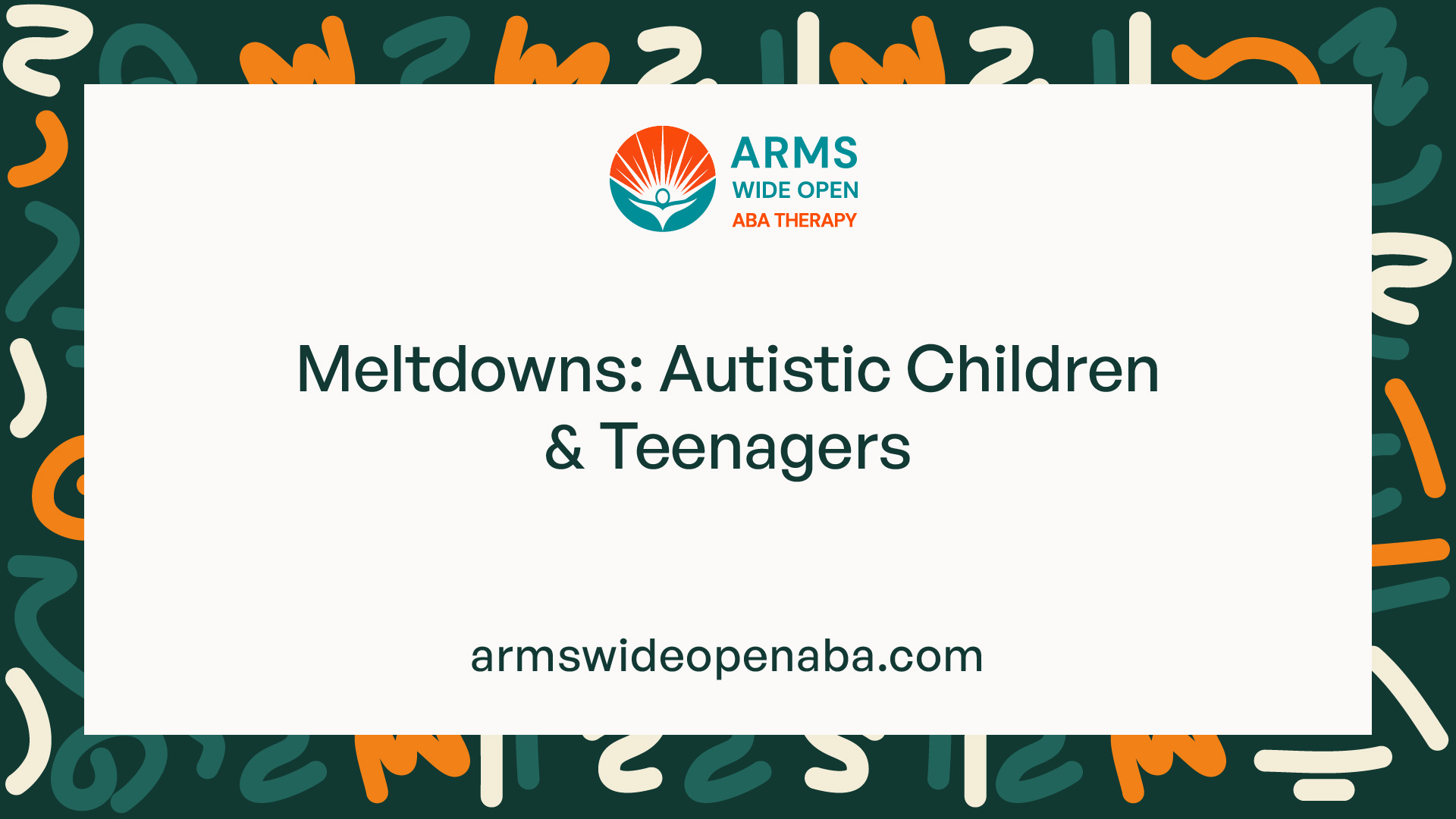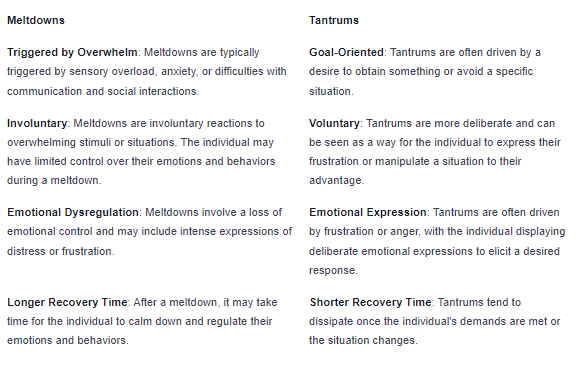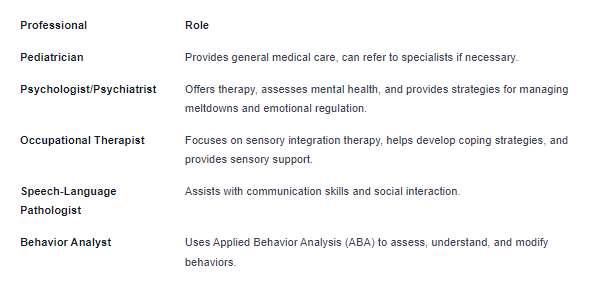Meltdowns: Autistic Children & Teenagers
Expert tips for managing meltdowns in autistic children & teenagers. Create a calm, supportive environment for emotional well-being.

Understanding Meltdowns in Autistic Children & Teenagers
When it comes to autistic children and teenagers, meltdowns are a common phenomenon. Understanding what meltdowns are and how they differ from tantrums is crucial in providing effective support and intervention.

What are Meltdowns?
Meltdowns are intense and often overwhelming responses to sensory, emotional, or environmental triggers. They are involuntary reactions that can be triggered by various factors, such as sensory overload, unexpected changes, or difficulties with communication and social interactions.
During a meltdown, an autistic individual may experience a loss of control over their emotions and behaviors. This can manifest in a range of ways, including crying, screaming, hitting, or self-injurious behaviors. It is important to note that meltdowns are not deliberate acts of defiance or manipulation; they are a result of the individual's unique neurology and the challenges they face.
Differentiating Meltdowns from Tantrums
While meltdowns may appear similar to tantrums, there are key differences between the two. Understanding these distinctions is vital to responding appropriately and providing the necessary support.

By understanding the nature of meltdowns and differentiating them from tantrums, parents, caregivers, and educators can respond with empathy and provide appropriate support to help the individual navigate these challenging moments. It is important to focus on creating a safe and supportive environment that promotes emotional regulation and helps prevent meltdowns whenever possible.
Triggers and Warning Signs
Understanding the triggers and warning signs of meltdowns in autistic children and teenagers is crucial for effective management and support. By identifying the factors that lead to meltdowns and recognizing the warning signs, caregivers and parents can take proactive steps to prevent or mitigate the impact of meltdowns.
Common Triggers for Meltdowns
Meltdowns in autistic children and teenagers can be triggered by various factors. While triggers may vary from individual to individual, some common triggers include:
Triggers
Sensory Overload
Changes in Routine
Communication Difficulties
Unexpected Transitions
Emotional Overwhelm
Environmental Stressors
Lack of Sleep or Fatigue
It is important to note that triggers can be unique to each individual, and understanding the specific triggers for a child or teenager is essential for effective management.
Recognizing Warning Signs
Recognizing the warning signs that precede a meltdown is vital for early intervention and support. By identifying these signs, caregivers and parents can intervene before the situation escalates. Warning signs can manifest in various ways and may include:
- Increased agitation or restlessness
- Heightened anxiety or fear
- Changes in breathing or heart rate
- Verbal or physical aggression
- Withdrawal or social isolation
- Repetitive behaviors or stimming
- Difficulty focusing or following instructions
Being attuned to these warning signs can enable caregivers and parents to implement strategies that help regulate emotions and prevent meltdowns from escalating.
By understanding the common triggers and recognizing the warning signs, caregivers and parents can create a supportive environment that minimizes the likelihood of meltdowns. It is important to remember that each child or teenager is unique, and their triggers and warning signs may vary. Tailoring strategies and interventions to meet their specific needs can greatly contribute to their overall well-being and help them navigate challenging situations more effectively.
Strategies for Dealing with Meltdowns
When it comes to managing meltdowns in autistic children and teenagers, employing effective strategies is essential. By creating a calming environment, establishing predictability and routine, and providing sensory support, caregivers can help mitigate meltdowns and promote a sense of calm.
Creating a Calming Environment
Creating a calming environment is crucial in preventing and managing meltdowns. This involves minimizing sensory overload and providing a soothing atmosphere. Consider the following strategies:
- Reduce sensory stimuli: Limit excessive noise, bright lights, and strong smells that can overwhelm the individual. Providing a quiet and dimly lit space can help create a calming environment.
- Designate a safe space: Create a designated area where the child or teenager can retreat when feeling overwhelmed. This space should be personalized with comforting items and sensory tools that the individual finds soothing.
- Encourage relaxation techniques: Introduce calming activities such as deep breathing exercises, listening to soft music, or using sensory toys. These techniques can help regulate emotions and promote relaxation during challenging moments.
Establishing Predictability and Routine
Autistic individuals often thrive in predictable and structured environments. Establishing routines can help reduce anxiety and provide a sense of security. Consider the following strategies:
- Develop a visual schedule:Use visual aids such as charts or calendars to outline daily activities and routines. This provides a clear understanding of what to expect and helps the individual prepare for transitions. Maintain consistency: Stick to established routines as much as possible. Consistency helps minimize surprises and provides a sense of stability, reducing the likelihood of meltdowns.
- Provide advance notice: When changes to the routine are unavoidable, provide advance notice and explain the reasons behind the change. This allows the individual to mentally prepare and adapt to the new situation.
Providing Sensory Support
Many autistic individuals have sensory sensitivities, and addressing their sensory needs is crucial in managing meltdowns. Consider the following strategies:
- Identify sensory triggers: Observe and identify specific sensory triggers that may lead to meltdowns. These triggers can include loud noises, certain textures, or strong smells. Once identified, take steps to minimize or avoid these triggers.
- Offer sensory tools: Provide access to sensory tools that can help regulate sensory input. This can include items such as fidget toys, weighted blankets, or noise-canceling headphones. These tools can provide comfort and help redirect sensory focus during overwhelming situations.
- Create a sensory-friendly environment: Make modifications to the environment to accommodate sensory needs. This can involve adjusting lighting, using soft fabrics, or providing opportunities for movement and physical activity.
By implementing these strategies, caregivers can support autistic children and teenagers in managing meltdowns effectively. Creating a calming environment, establishing predictability and routine, and providing sensory support are key steps towards fostering a sense of stability and promoting emotional well-being.
Communication and Emotional Regulation
When it comes to dealing with meltdowns in autistic children and teenagers, effective communication skills and emotional regulation techniques play a vital role. By focusing on these aspects, caregivers and individuals can better understand and manage meltdowns.
Teaching Effective Communication Skills
One of the key strategies in dealing with meltdowns is teaching autistic children and teenagers effective communication skills. Communication difficulties can often contribute to the frustration and anxiety that lead to meltdowns. By enhancing their ability to express themselves, individuals can better communicate their needs, thoughts, and emotions, reducing the likelihood of meltdowns.
Here are some techniques and approaches that can help in teaching effective communication skills:
- Visual supports: Using visual aids such as pictures, symbols, or visual schedules can assist in improving communication and providing a visual representation of expectations and routines.
- Social stories: Social stories are short narratives that describe social situations and appropriate behaviors. These stories can help individuals understand and navigate various social interactions, leading to improved communication.
- Augmentative and alternative communication (AAC): AAC systems, including picture-based communication boards or electronic devices, can aid non-verbal individuals in expressing their thoughts and needs effectively.
- Speech and language therapy: Engaging in speech and language therapy can provide individuals with tools and techniques to improve their verbal communication skills.
Implementing Emotional Regulation Techniques
Emotional regulation is another crucial aspect in managing meltdowns. Autistic children and teenagers may struggle with identifying and managing their emotions, which can contribute to the intensity and duration of meltdowns. By implementing emotional regulation techniques, individuals can better understand and manage their emotions, leading to a reduction in meltdowns.
Here are some techniques that can be helpful in promoting emotional regulation:
- Deep breathing exercises: Deep breathing techniques, such as belly breathing or square breathing, can help individuals calm their bodies and regulate their emotions during moments of distress.
- Sensory strategies: Engaging in sensory activities, such as using fidget toys, listening to calming music, or engaging in deep pressure activities, can provide individuals with a sense of comfort and help regulate their emotions.
- Mindfulness and meditation: Practicing mindfulness and meditation techniques can assist individuals in becoming more aware of their emotions and developing the ability to respond to them in a calm and controlled manner.
- Social-emotional learning: Participating in social-emotional learning programs or activities can provide individuals with skills and strategies to recognize and regulate their emotions effectively.
Implementing these communication and emotional regulation techniques can significantly contribute to managing meltdowns in autistic children and teenagers. By enhancing communication skills and promoting emotional regulation, caregivers and individuals can work together to create a more supportive and understanding environment.
Support and Resources
When dealing with meltdowns in autistic children and teenagers, it's important to have a solid support system in place. Building a support network, seeking professional help, and accessing community resources are key steps in providing the necessary support for both the child and their caregivers.
Building a Support Network
Creating a support network is crucial for parents and caregivers of autistic children and teenagers. Having a strong network of understanding individuals can provide emotional support, practical advice, and a sense of community. Here are some ways to build a support network:
- Join Support Groups: Look for local or online support groups specifically for parents or caregivers of autistic children. These groups offer a safe space to share experiences, ask questions, and connect with others who are going through similar situations.
- Connect with Autism Organizations: Reach out to autism organizations in your area. They often offer support groups, workshops, and resources for families dealing with meltdowns and other challenges associated with autism.
- Seek Support from Friends and Family: Inform close friends and family members about your child's needs and challenges. They can provide understanding, respite care, and assistance when needed.
- Utilize Online Communities:Onli ne forums and social media groups dedicated to autism can be valuable sources of support. Engaging with these communities allows you to connect with individuals from different backgrounds who can offer advice and support.
Seeking Professional Help
In some cases, seeking professional help is necessary to address meltdowns and associated issues effectively. Professionals with expertise in autism can provide guidance, assessment, and specialized interventions. Here are some professionals who can assist:

Accessing Community Resources
Communities often have resources available to support families dealing with meltdowns in autistic children and teenagers. These resources can provide additional assistance and guidance. Here are some community resources to consider:
- Local Autism Centers or Clinics: These centers often offer a range of services, including therapy, support groups, and educational resources.
- School Support Services: Schools may have special education programs, individualized education plans (IEPs), and access to therapists or counselors who can help manage meltdowns within the educational setting.
- Nonprofit Organizations: Nonprofit organizations focused on autism can provide resources, workshops, and funding opportunities for families.
- Government Assistance Programs: Investigate government programs that offer financial assistance, respite care, and other support services for families with special needs children.
By building a support network, seeking professional help, and accessing community resources, caregivers of autistic children and teenagers can find the support and guidance they need to navigate meltdowns and provide a nurturing environment for their loved ones. Remember, you are not alone, and there are resources available to assist you on this journey.
Conclusion
Managing meltdowns in autistic children and teenagers requires patience, understanding, and a willingness to adapt. By employing effective strategies such as creating a calming environment, establishing predictability and routine, providing sensory support, teaching effective communication skills, and promoting emotional regulation, caregivers can help mitigate meltdowns and promote emotional well-being.
Remember that each individual with autism is unique, and what works for one may not work for another. It's important to tailor interventions to meet the specific needs of the child or teenager. Building a strong support network, seeking professional help when necessary, and accessing community resources can also provide invaluable assistance for both the individual with autism and their caregivers.
By working together to create a supportive environment that fosters growth and development, individuals with autism can thrive and reach their full potential. With patience, understanding, and effective strategies in place, managing meltdowns can become a manageable challenge rather than an insurmountable obstacle.
Sources
https://www.verywellhealth.com/what-is-an-autistic-meltdown-260154
https://www.ambitiousaboutautism.org.uk/information-about-autism/behaviour/meltdowns-and-shutdowns
Similar articles
We’re here to help you

Our team is here to assist you in this process. Contact us for any assistance.
it’s easy to apply
We Accept Most Insurances
Our in-network insurance partnerships make ABA therapy more accessible to families throughout our service areas.







Our Insurance Process
We'll request your insurance details to help us verify your plan's coverage for ABA therapy. Once we've received this information, we'll walk you through your benefits, including copayments, deductibles and out-of-pocket maximums, so you know what to expect in advance.
Our team will then handle the preauthorization and all the necessary paperwork.
.svg)





















.jpeg)


































.jpeg)




.jpeg)







.jpeg)











.jpeg)
















